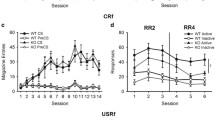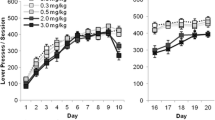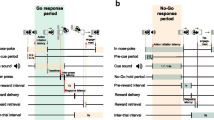Abstract
These experiments assessed whether reported increases in food consumption and food-reinforced instrumental performance in undeprived rats by the 5-HT1A agonist 8-hydroxy-2(di-n-propylamino)tetralin (8-OH-DPAT) are due to an increment in the incentive value of foods. Against this hypothesis, we found that when undeprived rats were trained to lever press for the food pellets and then allowed to consume the pellets under 8-OH-DPAT, this reexposure decreased subsequent instrumental extinction performance regardless of test drug condition relative to reexposure under vehicle. Although both food consumption and reinforced lever press performance were incremented, 8-OH-DPAT was found generally to reduce instrumental extinction performance and lever pressing during a period when the reinforcer was delivered non-contingently. Rats injected with 8-OH-DPAT were, however, more sensitive to delay of reinforcement, and increased their lever press performance at a 3-s delay but decreased performance at 6-s and 12-s delays relative to animals injected with vehicle. These results are consistent with the hypothesis that 8-OH-DPAT modifies arousal processes in a manner similar to mild stress, thereby acting both to elevate rewarded instrumental performance and to increase sensitivity to the effects of non-reward.
Similar content being viewed by others
References
Balleine BW (1992) The role of incentive learning in instrumental performance following shifts in primary motivation. J Exp Psychol [Anim Behav Proc] 18:236–250
Balleine BW, Dickinson A (1994) The role of cholecystokinin in the motivational control of instrumental action. Behav Neurosci 108:590–605
Balleine BW, Ball J Dickinson A (1994) Benzodiazepine-induced outcome revaluation and the motivational control of instrumental action. Behav Neurosci 108:573–589
Balleine BW, Davies A Dickinson A (1995) Cholecystokinin attenuates incentive learning in rats. Behav Neurosci 109:312–319
Bizot JC, Thiebot MH, Le Bihan C, Soubrie P, Simon P (1988) Effects of imipramine-like drugs and serotonin uptake blockers on delay of reward in rats. Possible implication in the behavioral mechanism of action of antidepressants. J Pharmacol Exp Ther 246:1144–1151
Bonvento G, Scatton B, Claustre Y, Rouquier L (1992) Effect of local injection of 8-OH-DPAT into the dorsal or median raphe on extracellular levels of serotonin in serotonergic projection areas in the brain. Neurosci Lett 137:101–104
De Vry J, Glaser T, Schuurman T, Schreiber R, Traber J (1991) 5-HT1A receptors in anxiety. In: Briley M, File SE (eds) New concepts in anxiety. CRC Press, Boca Raton, pp 94–129
Dickinson A (1975) Suppressive and enhancing effects of footshock on food-reinforced operant responding following septal lesions in rats. J Comp Physiol Psychol 88:851–861
Dickinson A Balleine BW (1994) Motivational control of goaldirected action. Anim Learn Behav 22:1–18
Dickinson A, Pearce JM (1976) Preference and response suppression under different correlations between shock and a positive reinforcer in rats. Learn Motiv 7:66–85
Dourish CT, Hutson PH, Curzon G (1985a) Low doses of the putative serotonin agonist 8-hydroxy-2-(di-n-propylamino)tetralin (8-OH-DPAT) elicit feeding in the rat. Psychopharmacology 86:197–204
Dourish CT, Hutson PH, Curzon G (1985b) Characteristics of feeding induced by the serotonin agonist 8-hydroxy-2-(di-n-propylamino)tetralin (8-OH-DPAT). Brain Res Bull 15:377–384
Dourish CT, Clark ML, Iversen SD (1988) 8-OH-DPAT elicits feeding and not chewing: evidence from liquid diet studies and a diet choice test. Psychopharmacology 95:185–188
Ebenezer IS (1992) Effects of the 5-HT1A agonist 8-OH-DPAT on operant food intake in non-deprived rats. Neuro Report 3:62–64
Fletcher PJ (1987) 8-OH-DPAT elicits gnawing and eating of solid but not liquid foods. Psychopharmacology 92:192–195
Fletcher PJ (1991) Dopamine receptor blockade in nucleus accumbens or caudate nucleus differentially affects feeding induced by 8-OH-DPAT injected into dorsal or median raphe. Brain Res 552:181–189
Fletcher PJ (1993) A comparison of the effects of dorsal and median raphe injections of 8-OH-DPAT in three operant tasks measuring response inhibition. Behav Brain Res 54:187–197
Hutson PH, Dourish CT, Curzon G (1986) Neurochemical and behavioural evidence for mediation of the hyperphagic action of 8-OH-DPAT by 5-HT cell body autoreceptors. Eur J Pharmacol 129:347–352
Kreiss DS, Lucki I (1994) Differential regulation of serotonin (5-HT) release in the striatum and hippocampus by 5-HT(1A) autoreceptors of the dorsal and median raphe nuclei. J Pharmacol Exp Ther 269:1268–1279
McBlane JW, Handley SL (1994) Effects of 2 stressors on behaviour in the elevated X-maze: preliminary investigation of their interaction with 8-OH-DPAT. Psychopharmacology 116:173–182
Montgomery AMJ, Wilner P, Muscat R (1988) Behavioural specificity of 8-OH-DPAT-induced feeding. Psychopharmacology 94:110–114
Muscat R, Montgomery AMJ, Wilner P (1989) Blockade of 8-OH-DPAT-induced feeding by dopamine antagonists. Psychopharmacology 99:402–408
Pearce JM, Dickinson A (1975) Pavlovian counterconditioning: changing the suppressive properties of shock by association with food. J Exp Psychol Anim Behav Proc 104:170–177
Rasmusson AM, Goldstein LE, Deutch AY, Bunney BS, Roth RH (1994) 5-HT1A agonist 8-OH-DPAT modulates basal and stress-induced changes in medial prefrontal cortical dopamine. Synapse 18:218–224
Robbins TW, Fray PJ (1980) Stress-induced eating: fact, fiction or misunderstanding? Appetite 1:103–133
Tache Y, Yang H, Kaneko H (1995) Caudal raphe-dorsal vagal complex peptidergic projections: role in gastric vagal control. Peptides 16:431–435
Tanda G, Carboni E, Frau R, Di Chiara G (1994) Increase of extracellular dopamine in the prefrontal cortex: a trait of drugs with antidepressant potential? Psychopharmacology 115:285–288
Thiebot MH, Le Bihan C, Soubrie P, Simon P (1985) Benzodiazepines reduce the tolerance to reward delay in rats. Psychopharmacology 86:147–152
Wogar MA, Bradshaw CM, Szabadi E (1993a) Effect of lesions of the ascending 5-hydroxytryptaminergic pathways on choice between delayed reinforcers. Psychopharmacology 111:239–243
Wogar M.A, Bradshaw CM, Szabadi E (1993b) Does the effect of central 5-hydroxytryptamine depletion on timing depend on motivational change? Psychopharmacology 112:86–92
Author information
Authors and Affiliations
Rights and permissions
About this article
Cite this article
Balleine, B.W., Fletcher, N. & Dickinson, A. Effect of the 5-HT1A agonist, 8-OH-DPAT on instrumental performance in rats. Psychopharmacology 125, 79–88 (1996). https://doi.org/10.1007/BF02247396
Received:
Revised:
Issue Date:
DOI: https://doi.org/10.1007/BF02247396




